THE SIMPLEST 555 OSCILLATOR
The simplest 555 oscillator takes output pin 3 to capacitor C1 via resistor R1.
When the circuit is turned on, C1 is uncharged and output pin 3 is HIGH. C1 charges via R1 and when Pin 6 detects 2/3 rail voltage, output pin 3 goes LOW. R1 now discharges capacitor C1 and when pin 2 detects 1/3 rail voltage, output pin 3 goes HIGH to repeat the cycle.
The amount of time when the output is HIGH is called the MARK and the time when the output is LOW is called the SPACE.
In the diagram, the mark is the same length as the space and this is called 1:1 or 50%:50%.
If a resistor and capacitor (or electrolytic) is placed on the output, the result is very similar to a sinewave.

C1 to POSITIVE RAIL
C1 can be connected to the positive rail. This is not normal practice, however it does work.
The output frequency changes when the capacitor is changed from the negative rail to the positive rail. Theoretically the frequency should not change, but it does, and that's why you have to check everything. The frequency of operation in this arrangement is different to connecting the components via pin7 because pin3 does not go to full rail voltage or 0v. This means all the output frequencies are lower than those in the "555 Frequency Calculator."
The table shows the frequency for the capacitor connected to the 0v rail and 12v rail: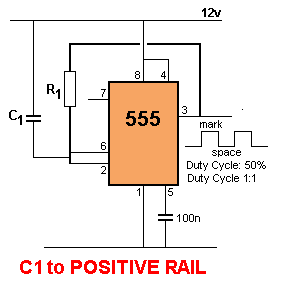
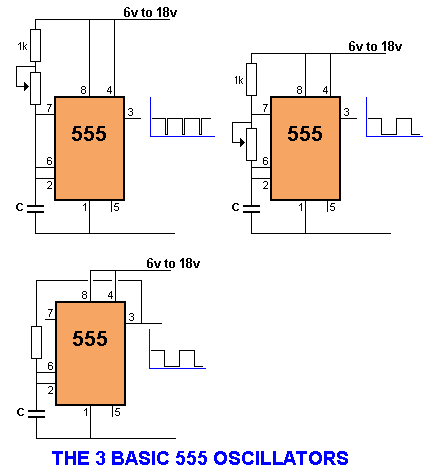
The simplest 555 oscillator takes output pin 3 to capacitor C1 via resistor R1.
When the circuit is turned on, C1 is uncharged and output pin 3 is HIGH. C1 charges via R1 and when Pin 6 detects 2/3 rail voltage, output pin 3 goes LOW. R1 now discharges capacitor C1 and when pin 2 detects 1/3 rail voltage, output pin 3 goes HIGH to repeat the cycle.
The amount of time when the output is HIGH is called the MARK and the time when the output is LOW is called the SPACE.
In the diagram, the mark is the same length as the space and this is called 1:1 or 50%:50%.
If a resistor and capacitor (or electrolytic) is placed on the output, the result is very similar to a sinewave.

C1 to POSITIVE RAIL
C1 can be connected to the positive rail. This is not normal practice, however it does work.
The output frequency changes when the capacitor is changed from the negative rail to the positive rail. Theoretically the frequency should not change, but it does, and that's why you have to check everything. The frequency of operation in this arrangement is different to connecting the components via pin7 because pin3 does not go to full rail voltage or 0v. This means all the output frequencies are lower than those in the "555 Frequency Calculator."
The table shows the frequency for the capacitor connected to the 0v rail and 12v rail:

C1 to 0v rail
|
C1 to 12v rail
| ||||
| 1k | 1n | 505kHz | 1k | 1n | 255kHz |
| 1k | 10n | 115kHz | 1k | 10n | 130kHz |
| 1k | 100n | 23kHz | 1k | 100n | 16kHz |
| 10k | 1n | 112kHz | 10k | 1n | 128kHz |
| 10k | 10n | 27kHz | 10k | 10n | 16kHz |
| 10k | 100n | 3700Hz | 10k | 100n | 1600Hz |
CHANGING THE MARK-SPACE RATIOThis ratio can be altered by adding a diode and resistor as shown in the following diagrams. In the first diagram, the 555 comes ON ("fires-up") with pin 3 low and pin 2 immediately detects this low and makes pin 3 HIGH. The 10n is quickly charged via the diode and 4k7 and this is why the MARK is "short." When the capacitor is 2/3Vcc, pin 6 detects a HIGH and the output of the 555 goes LOW. The 10n is discharged via the 33k and this creates the long-duration SPACE (LOW). The second diagram creates a long-duration HIGH:
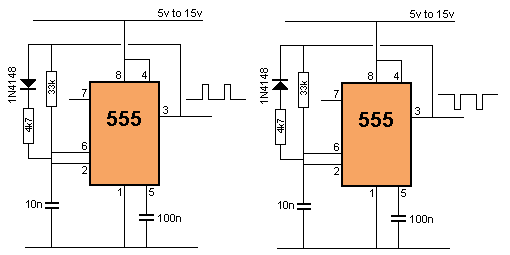

--------------------------------------------------------------------------------------------------------
THE THREE BASIC 555 OSCILLATORSThe 3 basic 555 oscillators are shown in these circuits.
The basic points to remember are these:
Pin 7 goes LOW when pin 3 goes LOW.
Pin 6 detects a HIGH
Pin 2 detects a LOW
Pin 3 can be used instead of the supply-rail to deliver a HIGH and instead of pin 7 to deliver a LOW to the timing section made up of pins 2&6 and "C" and a timing resistor.
The basic points to remember are these:
Pin 7 goes LOW when pin 3 goes LOW.
Pin 6 detects a HIGH
Pin 2 detects a LOW
Pin 3 can be used instead of the supply-rail to deliver a HIGH and instead of pin 7 to deliver a LOW to the timing section made up of pins 2&6 and "C" and a timing resistor.

----------------------------------------------------------------------------------------------------------------------------------
HOW TO REMEMBER THE PINS:
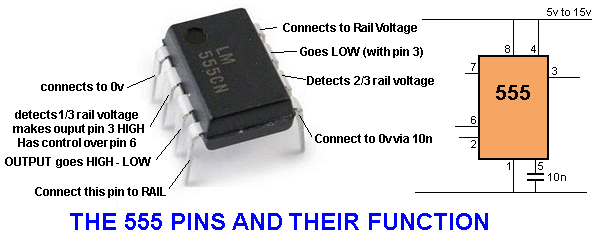

---------------------------------------------------------------------------------
INSIDE THE 555
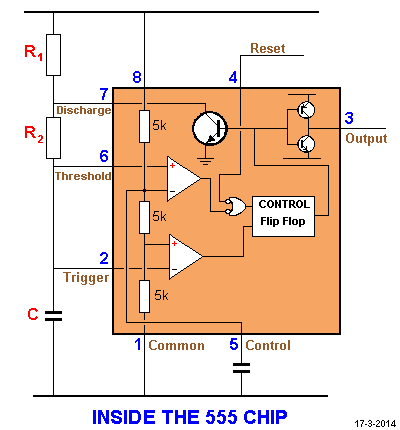
Note: Pin 7 is "in phase" with output Pin 3 (both are low at the same time).
Pin 7 "shorts" to 0v via a transistor. It is pulled HIGH via R1.
Maximum supply voltage 16v - 18v
Current consumption approx 10mA
Output Current sink @5v = 5 - 50mA @15v = 50mA
Output Current source @5v = 100mA @15v = 200mA
Maximum operating frequency 300kHz - 500kHz
Faults with Chip:
Consumes about 10mA when sitting in circuit
Output voltage can be up to 2.5v less than rail voltage Output can be 0.5v to 1.5v above groundSources up to 200mA
Some chips sink only 50mA, some will sink 200mA
A NE555 was tested at 1kHz, 12.75v rail and 39R load. The Results:
Output voltage 0.5v low, 11.5v high at output current of 180mA The "test chip" performance was excellent.

Note: Pin 7 is "in phase" with output Pin 3 (both are low at the same time).
Pin 7 "shorts" to 0v via a transistor. It is pulled HIGH via R1.
Maximum supply voltage 16v - 18v
Current consumption approx 10mA
Output Current sink @5v = 5 - 50mA @15v = 50mA
Output Current source @5v = 100mA @15v = 200mA
Maximum operating frequency 300kHz - 500kHz
Faults with Chip:
Consumes about 10mA when sitting in circuit
Output voltage can be up to 2.5v less than rail voltage Output can be 0.5v to 1.5v above groundSources up to 200mA
Some chips sink only 50mA, some will sink 200mA
A NE555 was tested at 1kHz, 12.75v rail and 39R load. The Results:
Output voltage 0.5v low, 11.5v high at output current of 180mA The "test chip" performance was excellent.
-------------------------------------------------------------------------------------------------------------------------------------------------------------------










No comments:
Post a Comment